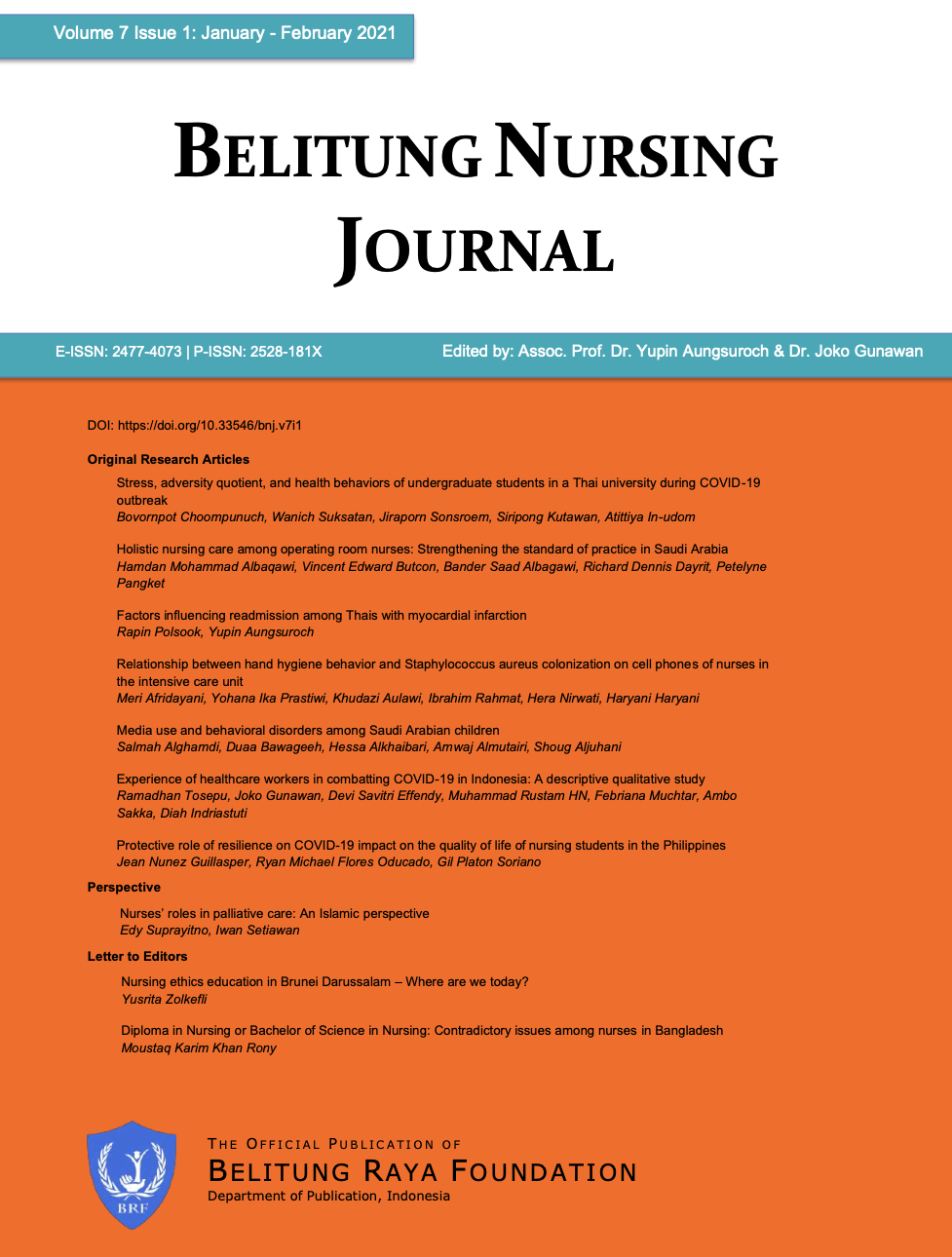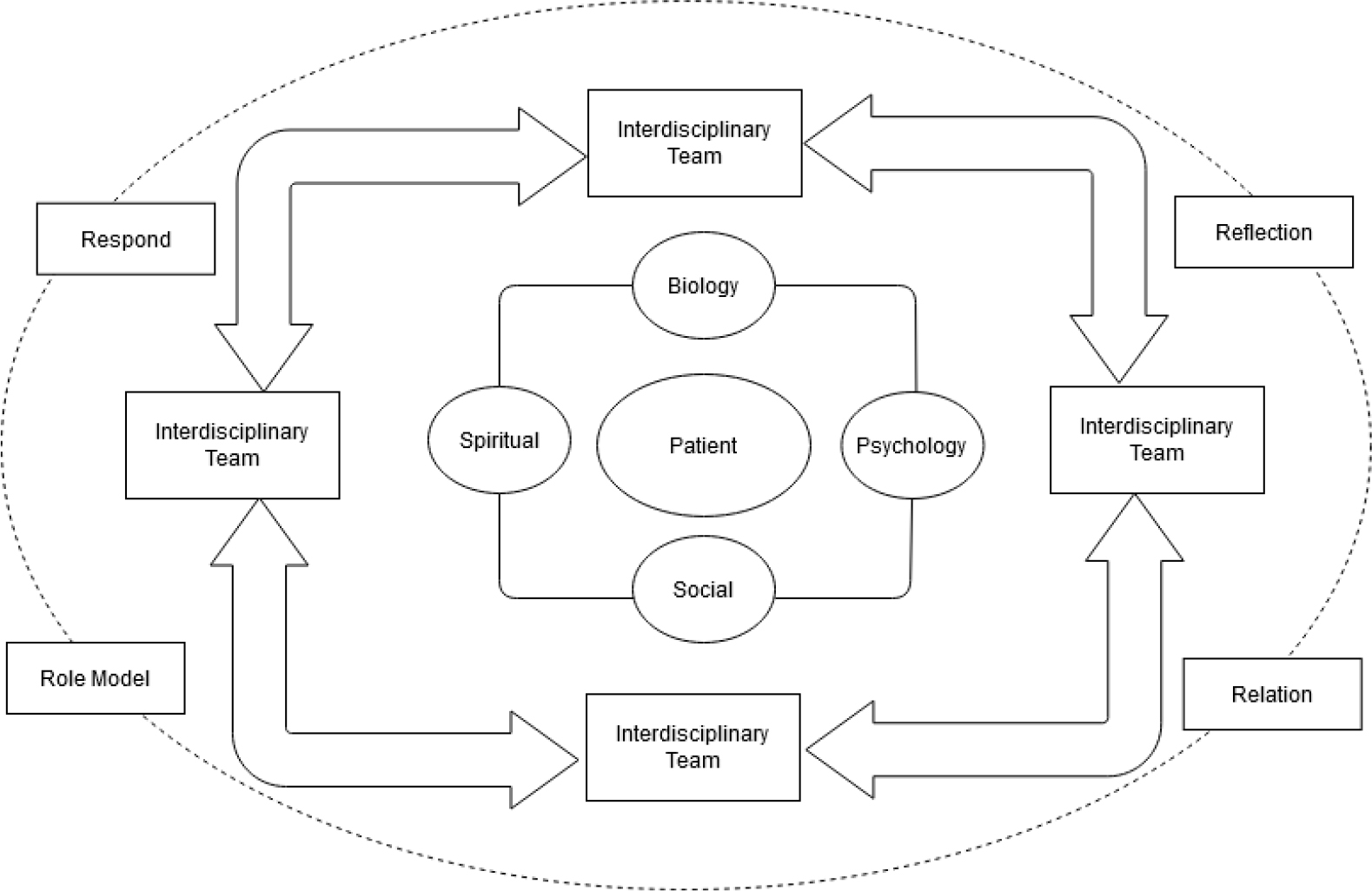Islam views that humans are the perfect creatures (Al-Ghazali, 2007). However, Allah explains that humans will experience weak physical conditions (illness). It is cited in the Holy Qur’an (30:54), “It is Allah Who created you in a state of weakness; then after weakness, He gave you strength, then after strength, He made you weak and old. He creates what He pleases. He is All-Knowing, All-Powerful”. This verse gives a signal that humans were created weak (at birth) then become strong then turn gray (weak, old, or sick) which needs treatment”. Therefore, the role of palliative care is significant in Islam, as every human will be weak when they get old.
Palliative care can be provided in various contexts, such as hospitals, outpatients, and home settings, and applied according to cultural beliefs. This article offers an Islamic perspective about nurses’ roles in palliative care, which can be used worldwide, especially in Muslim-majority countries. The total population of Muslims in the world in 2015 reached 1.9 billion (World Population Review, 2020), and by 2050 it is predicted that Islam will spread and grow faster than other religions in the world (Leong et al., 2016).
World Health Organization (WHO) explains that palliative care is an approach to improving the patients’ life quality and their families in dealing with life-threatening diseases. It includes prevention and cure of suffering through early detection, assessment, and treatment of illness and other conditions, including biological, psychological, social, and spiritual conditions (World Palliative Care Alliance, 2014). In providing care to palliative patients, nurses must involve the patient’s awareness, faith, and belief (Dewiyuliana et al., 2019; Rassool, 2015). According to Muishout et al. (2018), all Muslim patients who experience palliative care always want a good death (or Husnul Khotimah) and get good care according to the expected standard. Understanding Islamic beliefs will help nurses provide professional and culturally sensitive nursing care. It might happen by implementing religion, family perceptions, health, illness, medicine, and privacy issues (Attum et al., 2018).
Death or nearly death is a current issue in terminal patients (Zahedi et al., 2007). It cannot be denied that Muslim nurses’ role is crucial, especially in providing palliative nursing care. The Prophet Muhammad SAW said that Allah SWT would not bring down a disease other than to bring down the antidote, except one: old age/death. This is explained in the Hadith of Sahih Muslim (43).
This article aims to open up new ideas rather than provide a definitive answer.
Palliative Care Aspects
Some aspects that must be considered in providing palliative nursing care, including (1) upholding ethical aspects of care (nonmaleficence, justice, autonomy, and beneficence), maintaining politeness and respect, patient environmental cleanliness, social aspects, prayer (praying or praying for), (2) conveying what is being experienced by the patient (being honest with the patient), (3) giving opioids and sedatives, (4) giving healthy diets, (5) preparing for death and mourning, (6) completing all patient’s affairs, and (7) increasing worship (Al-Shahri & Al-Khenaizan, 2005). The other aspects are prayer, medical care, freedom of religious practice, modesty, professional care, pain management, and mental problems coping (Boucher et al., 2017).
When someone is nearly dead or in a critical condition, it is necessary to increase one’s closeness to God (in the form of worship) (Choong, 2015). Therefore, the interaction and trust between patients and nurses or other health workers should be enhanced (Al-Jahdali et al., 2013) to provide a positive end to life (Rosemond et al., 2017). In other words, palliative care should include bio-psycho-socio-spiritual aspects for families and patients (Hagan et al., 2018). According to Barolia (2008), the core category of caring is maintaining the balance of five dimensions (physical, ethical, moral, spiritual, and intellectual) of human beings through response, reflections, relationships, relatedness, and role modeling. Besides, nurses also need to coordinate with the team of professionals (interdisciplinary team) to achieve the goals (Al-Jahdali et al., 2013; Barolia, 2008; Choong, 2015; Labson et al., 2013) (Figure1).
According to Hagan et al. (2018), the roles of nurses in providing palliative nursing care include symptom/pain management, good communication, and advocacy to patients and families. Also, it is necessary to increase the spiritual aspect of the patients, which includes four aspects (Irajpour et al., 2018), including: (1) aspects of religiosity - religious rituals, religious values, and religious practices, (2) aspects of religious assistance - consultation about the meaning of life/death, help to achieve intellectual tendencies, improve communication with oneself and others, (3) aspects of psychology - instill calm in the patient, help patients to adapt, foster hope and enthusiasm, and empathy, and (4) supportive aspects - maintain the patient’s basic needs, homecare, create awareness and self-acceptance, and respect the patient.
Illness in the Perspective of Islam
Muslims must believe that all trials in life, including illness, are the tests for humans. Allah SWT has said in the Holy Qur’an (29:2), “Do people think that they will be let go merely by saying: “We believe, and that they will not be tested?”. The verse explains that everything that happens in life is a test for humans, including illness. Muslims firmly believe that humans will meet illness and death (must be patient and pray); thus, maintain respect for each other is essential while avoiding haram food (Rassool, 2015).
Allah promises that the test to be faced will be according to His servant’s ability. Allah says in the Holy Qur’an (2:286) that Allah does not lay responsibility on anyone beyond his/her capacity. Besides, humans must be patient in dealing with illness (as a part of the tests). Believers, be steadfast, and vie in steadfastness, stand firm in their faith, and hold Allah in fear that they may attain real success, described in the Holy Qur’an (3:200).
In addition, the interpretation of the Ministry of Religion of the Republic of Indonesia (1995) states that patience is carried out in various conditions, such as patience in carrying out God’s commands and prohibitions, struggling, and facing all kinds of trials and calamities. When facing a critical situation or experiencing difficulties, the patient’s welfare and care must be improved; friends and relatives are encouraged to visit. This is done as a tribute to the patient to provide comfort (Choong, 2015).
Besides, it is also a way to remind of spirituality. If there is a spiritual problem, it will cause disturbances in various aspects of the patient’s life (Stacey, 2018). Therefore, we must realize and believe that whatever happens in this life is the provision of Allah. It is written in the Holy Qur’an (6:59), “He has the keys to the realm that lies beyond the reach of human perception; none knows them but Him. And He knows what is on the land and in the sea. There is no leaf which falls that He does not know about, and there is no grain in the darkness of the earth or anything green or dry which has not been recorded in a Clear Book (Lohmahfuz)”.
A Death in Islam
In the Holy Qur’an (29:57), it is stated that every soul will die, then to Us, you will all be returned. Since the beginning, Muslims have been invited to realize that one day they will die. The hope is that every Muslim will be ready to die in peace and draw closer to Allah. All Muslims should always expect Allah’s forgiveness and mercy (Al-Shahri & Al-Khenaizan, 2005). Islam views death not as the end of life but, afterward, humans will be raised again in another life (or hereafter) (Asadi-Lari et al., 2008).
To achieve readiness in facing death, patients need to get comfort from nursing care services to reduce anxiety and depression (Nuraini et al., 2018). Allah SWT has confirmed in the Holy Qur’an (13:28), “Those who believe and whose hearts find comfort in the remembrance of Allah; surely, do hearts find comfort.”
Believers will have a peaceful heart because they always remember Allah. There will be no anxiety and fear or worry because people who always remember Allah will continue to do good things, and they will feel happy with the goodness they do (Goffar, 2004).
When a person’s condition gets worse, and he/she fears that he/she will die, several things need to be done as follows.
Having good prejudice to Allah. “And when he is nearing his death, let him have a good prejudice to Allah.” It is based on the Hadith of Jabir and Anas: “He heard the Prophet say before his death: Do not all of you die, except having good prejudice (Huznudzan) to Allah.” This is explained in the Hadith of Sahih Muslim (2877).
Leaving a will before death. If a person is seriously ill or feels that death is coming, Islam leads to leaving a will with the living. This is based on the word of Allah in the Holy Qur’an (2:180), “It is prescribed that when death approaches any of you—if they leave something of value—a will should be made in favor of parents and immediate family with fairness. This is an obligation on those who are mindful of Allah.”
Talqin (leading to pronounce). Unlike the general practice, the Muhammadiyah Tarjih Council determines the talqin as in the decision; “You should guide him to say to the person who is going to die by saying the sentence La-ila-ha illallah (There is no God but Allah).” It is based on the Hadith of Abu Sa’id: “From the Prophet SAW, he said: Guide to say to those who will die by saying La-ila-ha illallah.” This is explained in the Hadith of Sahih Muslim (916).
Facing the Qibla. It is according to the Hadith of Abu Qatada. When Bara’ bin Ma’rur had a will to come to Kaaba and face the Qibla, the Prophet SAW said, “He matches his fitra (original disposition).”
Early Actions on the Dead
After a severe illness that cannot be helped and then dies, several things need to be done immediately by the relatives and people who are still alive. Those include:
Closing their eyes and praying for them. This is explained in the Hadith of Ummi Salamah, “Rasulullah Peace Be Upon Him (PUBH) came to Abi Salamah (when he died) and his eyes were open, so he closed them.” Then the Prophet PUBH said, “Certainly the spirit, if released, is followed by the eye.” He also said to the people, “Do not pray for yourself, except for good, because actually, the angel agrees with what you say.” Then he said again, “O Allah, forgive Abu Salamah, uphold his rank as high as the degree of those who are righteous, open it and give change after he dies.” This is explained in the Hadith of Sahih Muslim (1524).
Covering them with good cloth. This is described in the Hadith of Aisyah RA, “That when Rasulullah PUBH died, he was devoured with a hibarah cloth (a type of patterned Yemeni cloth).”
Paying off their debt. One of the things that need to be done when someone dies is to pay off the debt concerned immediately. This is based on the Hadith of Abu Hurairah, in which the Prophet PUBH said, “The life of a Mu’min depends on his debt until he is repaid.”
Taking care of the body. After someone is declared to be dead, the body must be treated immediately. This is based on the Hadith of Ali, in which Rasulullah PUBH said, “Three cases, O Ali, must not be postponed, including prayer when the time comes, the body when it is clearly said to be dead, and a woman who does not have a husband if she finds her soul mate” (Al-Albani, 2014).
Spreading the death news. When someone dies, the next action is to immediately spread the word to relatives, friends, and Muslims. This is based on the Hadith of Bukhari Muslim, in which Rasulullah PUBH was told about the man who swept the mosque died and buried that night. He said, “Don’t you want to tell me?”
Discussion
Generally, the nurse’s treatment in providing care covers several aspects: giving their respects to the patient, being ready, being realistic, having empathy and care, sensitivity, empowering the patients, and discipline (Ciemins et al., 2015). The applications of Islamic values in the nursing practice include: (1) nursing care performed by professional nurses with good skills and behavior in taking care of dying patients (Muishout et al., 2018), (2) providing opportunities for patients to rest and gather with the family, (3) reminding about the greatness of Allah (God), happiness, and good rewards, (4) giving the patient religious therapy by reciting the Holy Qur’an, (5) discussing the hope towards Allah (God), (6) encouraging the patient to pray, (7) encouraging them to have a good deed and worship, (8) giving them a chance to deliver the last hope of the patients (relation between nurse and patient) (Haugan, 2014), (9) actions before death - reminding patients that an illness is not a punishment from Allah and should be faced as a test, doing thahara for Muslim who cannot do the ablution (according to Islamic law, it is the act of purifying oneself from ritual uncleanness or even impurity or najis until someone fulfills the requirements to perform certain actions to worship Allah). If there is no possibility of living, the medical team may do Do Not Resuscitate (DNR). Suicide is not the way the Muslims die; it is not allowed. Giving additional nutrition could be done as long as it is good and not harming the patient (explained in the Holy Qur’an 2:168). Lead the patients to recite Laa-ilaaha illallah during their dying situation, and (10) actions after the death, such as closing patients’ eyes and covering the corpse with the shroud. Grieving or mourning for a long time is not allowed; organ donation may be possible with family permission and an agreement not to be traded (Shuriye, 2011). Also, the cremation of the corpse is not allowed (Leong et al., 2016).
Given the importance of the Islamic values in nursing practice, there are challenges in its application, such as the policy and system that may not support the integration of Islamic values to nursing practice. The policy most likely focuses on reducing the pain or other symptoms, reflecting a low spiritual aspect in nursing practice. In addition, there are still limited guidelines for the provision of spiritual care. Besides, although the concept of Islam in palliative care is not new among Muslim nurses; however, they may not perform it well. Palliative care requires high competence of nurses, especially in cultural competence and communication. Islam is often viewed at different levels of understanding and practice; thus, the communication skills of nurses should be improved for better care. Training in palliative care among nurses should be conducted regularly.
Conclusion
Islamic value provides a comprehensive approach in palliative care. Nurses are expected to apply this value in their practice to serve the patient as a whole person, rather than just someone with a health condition. It is also hoped that the health policymakers pay attention to the roles of Islamic values and integrate them in nursing practice, especially in palliative nursing care.










